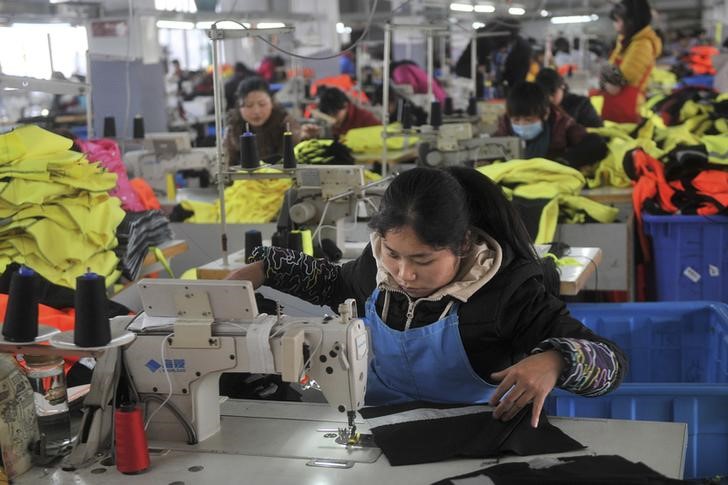By Koh Gui Qing and Kevin Yao
BEIJING (Reuters) - Growth in China's investment, retail sales and factory output all missed forecasts in January and February and fell to multi-year lows, leaving investors with little doubt that the economy is still losing steam and in need of further support measures.
The figures came a day after data showed deflationary pressures intensified in the factory sector in February, reinforcing expectations of more interest rate cuts and other policy loosening to avert a sharper slowdown in the world's second-largest economy.
"Activity data surprised the market on the downside by a large margin, suggesting that China's first quarter GDP growth could likely fall to below 7 percent," ANZ economist Li-Gang Liu said in a research note.
"In our view, the extremely weak data at the beginning of the year suggest that China needs to engage in more aggressive policy easing, and we see that a reserve requirement ratio (RRR) cut will be imminent," he said, adding that stimulus measures rolled out since last year seem to have had limited effect.
Industrial output grew 6.8 percent in the first two months of the year compared with the same period a year ago, the National Bureau of Statistics said on Wednesday, the weakest expansion since the global financial crisis in late 2008.
Analysts polled by Reuters had forecast a 7.8 percent rise, down slightly from December.
Retail sales rose 10.7 percent, the lowest pace in a decade and missing expectations for a 11.7 percent rise.
Fixed-asset investment, a crucial driver of the Chinese economy, rose 13.9 percent, the weakest expansion since 2001 and compared with estimates for a 15 percent gain.
"Fixed asset investment will likely face even more challenges," economists at Credit Suisse said in a note this week, adding that crackdowns on corruption and shadow banking have heavily squeezed spending by local governments.
"Local officials and executives at state owned enterprises are more worried about their jobs than investment ... The central government is pushing out more investment projects, but with the aim of partially offsetting losses in local investment, rather than accelerating growth."
China combines its January and February data releases for investment, retail sales and factory output to minimise distortions from the Lunar New Year holiday, which fell in late January last year but in mid-February this year.
Sluggish factory activity reinforces expectations that China's economic growth will slow to a quarter-century low of around 7 percent this year from 7.4 percent in 2014, even with expected additional stimulus measures.
Power generation rose 1.9 percent in January and February from a year earlier, well below 3.2 percent seen in all of 2014.
Yin Weimin, minister of human resources and social security, cautioned this week that China's labour market also faces greater pressure. Employment fell more in January and February than in the same period last year, he said, while adding that he was confident China can still create more than 10 million jobs this year.
BUCKLE SEAT BELTS
The Chinese economy has had a rough ride in the last 15 months as a property downturn compounded slackening growth in foreign and domestic demand and persistent industrial overcapacity. A widening corruption crackdown also has weighed on everything from investment to retail sales.
Policymakers have cut interest rates twice since November, and in early February reduced the amount of cash that banks must hold as reserves (RRR), freeing up fresh liquidity to flow into the economy to offset rising outflows of capital.
But because those adjustments so far have been largely defensive in nature, economists say, they haven't translated into lower real interest rates or increased investment. Chinese companies are cautious about expanding in the face of weak business prospects, and bankers are wary of a spike in non-performing loans.
With consumer inflation hovering near the government's "vigilance level" of around 1 percent, analysts expect the central bank to lower reserve requirements and interest rates again to head off a potential deflationary cycle, in what would be its biggest easing campaign since the global crisis.
The central bank has singled out the rise in real interest rates on the back of cooling inflation as a further drag on the economy, especially as many companies are struggling with heavy debt levels and end-user demand remains weak.
"Double-digit industrial production levels will be a thing of the past," said Chester Liaw, an economist at Forecast Pte in Singapore. "It is highly unlikely that retail sales will hold out for long above the 10 percent mark as well."
